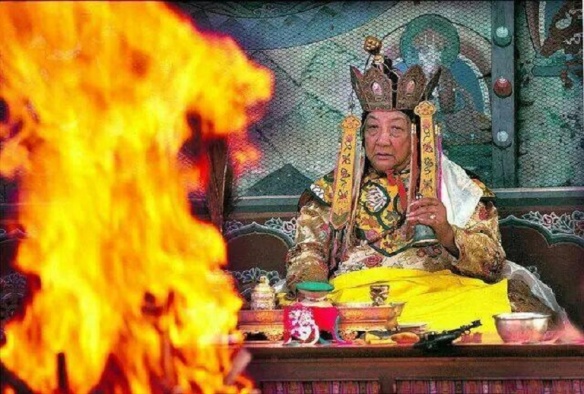I have performed divinatory services for clients since I was about eleven years old. As both a scholar and a practitioner, I am deeply fascinated by the incredible range of – but also significant similarities between – forms of divination as practiced across the centuries and the globe, and I know that readers of this blog – many of whom also practice some kind of divination – are too. With that in mind, I thought I’d offer some casual thoughts and a few original rough translations relating to Tibetan divination practices here, with a focus on one type of prognostication in particular: ‘phreng mo (pronounced treng moh), or divination through the use of a prayer beads or rosaries (‘phreng ba). Continue reading
Tag Archives: rosary
‘As Wealthy as a King’: Common Tools and Substances used in Mantra Healing

(A regal-looking Dilgo Khyentse Rinpoche (1910-1991), with tantric ritual bell or dril bu, seated behind a sbyin sreg or ‘burnt offering’ fire)
As a follow-up to my recent translation of Dr Nida Chenagtang’s chapter on how mantras work, I decided to translate a subsequent chapter in Dr Nida’s Mantra Healing book which deals with the ritual tools and substances most commonly used by ngakpa/ma. Dr Nida la gives a brief summary of some of the most salient ritual implements and objects used by mantra-healers and tantric wizards, and describes their functions, rationale, and construction, along with rules for their proper handling and use. The subject of ritual tools necessarily ties in which more general, theoretical reflections I have made on this blog about the role of materiality in magic and religion. How ought we to understand the status of magical, blessed or powerful objects or materials, in a Buddhist context where nothing that exists has any innate or enduring substantiality on the ultimate level, or for that matter where subtle, ‘imagined forms’ may be just as ontologically real, agentive, and efficacious as gross, material ones? As we saw in Dr Nida’s earlier chapter about mantras’ efficacy, the ultimate emptiness of phenomena is in fact directly related to their functionality or agency – it is precisely because material things are impermanent, compounded and conditional, that they are able to be transformed, and to transform in kind. Buddhist notions of dependent-origination and emptiness are wholesale dispensations that apply across divides of body-and-mind, real-and-representational, which are themselves also categories that operate quite differently in Buddhist philosophical contexts versus non-Buddhist ones. Continue reading
